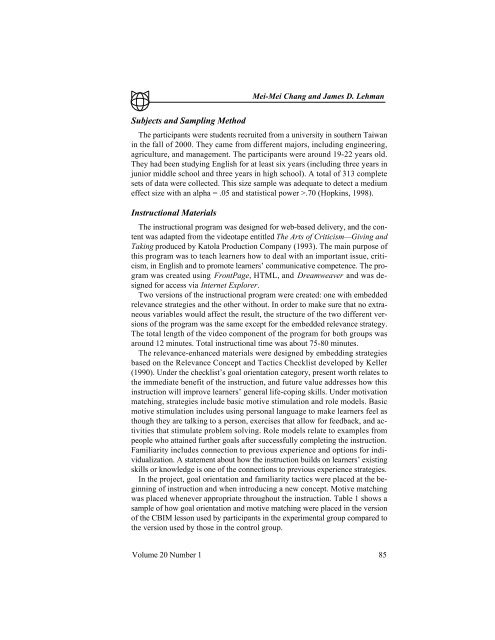Learning Foreign Language through an Interactive Multimedia ...
Learning Foreign Language through an Interactive Multimedia ...
Learning Foreign Language through an Interactive Multimedia ...
Create successful ePaper yourself
Turn your PDF publications into a flip-book with our unique Google optimized e-Paper software.
Subjects <strong>an</strong>d Sampling Method<br />
Mei-Mei Ch<strong>an</strong>g <strong>an</strong>d James D. Lehm<strong>an</strong><br />
The particip<strong>an</strong>ts were students recruited from a university in southern Taiw<strong>an</strong><br />
in the fall of 2000. They came from different majors, including engineering,<br />
agriculture, <strong>an</strong>d m<strong>an</strong>agement. The particip<strong>an</strong>ts were around 19-22 years old.<br />
They had been studying English for at least six years (including three years in<br />
junior middle school <strong>an</strong>d three years in high school). A total of 313 complete<br />
sets of data were collected. This size sample was adequate to detect a medium<br />
effect size with <strong>an</strong> alpha = .05 <strong>an</strong>d statistical power >.70 (Hopkins, 1998).<br />
Instructional Materials<br />
The instructional program was designed for web-based delivery, <strong>an</strong>d the content<br />
was adapted from the videotape entitled The Arts of Criticism—Giving <strong>an</strong>d<br />
Taking produced by Katola Production Comp<strong>an</strong>y (1993). The main purpose of<br />
this program was to teach learners how to deal with <strong>an</strong> import<strong>an</strong>t issue, criticism,<br />
in English <strong>an</strong>d to promote learners’ communicative competence. The program<br />
was created using FrontPage, HTML, <strong>an</strong>d Dreamweaver <strong>an</strong>d was designed<br />
for access via Internet Explorer.<br />
Two versions of the instructional program were created: one with embedded<br />
relev<strong>an</strong>ce strategies <strong>an</strong>d the other without. In order to make sure that no extr<strong>an</strong>eous<br />
variables would affect the result, the structure of the two different versions<br />
of the program was the same except for the embedded relev<strong>an</strong>ce strategy.<br />
The total length of the video component of the program for both groups was<br />
around 12 minutes. Total instructional time was about 75-80 minutes.<br />
The relev<strong>an</strong>ce-enh<strong>an</strong>ced materials were designed by embedding strategies<br />
based on the Relev<strong>an</strong>ce Concept <strong>an</strong>d Tactics Checklist developed by Keller<br />
(1990). Under the checklist’s goal orientation category, present worth relates to<br />
the immediate benefit of the instruction, <strong>an</strong>d future value addresses how this<br />
instruction will improve learners’ general life-coping skills. Under motivation<br />
matching, strategies include basic motive stimulation <strong>an</strong>d role models. Basic<br />
motive stimulation includes using personal l<strong>an</strong>guage to make learners feel as<br />
though they are talking to a person, exercises that allow for feedback, <strong>an</strong>d activities<br />
that stimulate problem solving. Role models relate to examples from<br />
people who attained further goals after successfully completing the instruction.<br />
Familiarity includes connection to previous experience <strong>an</strong>d options for individualization.<br />
A statement about how the instruction builds on learners’ existing<br />
skills or knowledge is one of the connections to previous experience strategies.<br />
In the project, goal orientation <strong>an</strong>d familiarity tactics were placed at the beginning<br />
of instruction <strong>an</strong>d when introducing a new concept. Motive matching<br />
was placed whenever appropriate <strong>through</strong>out the instruction. Table 1 shows a<br />
sample of how goal orientation <strong>an</strong>d motive matching were placed in the version<br />
of the CBIM lesson used by particip<strong>an</strong>ts in the experimental group compared to<br />
the version used by those in the control group.<br />
Volume 20 Number 1 85
















